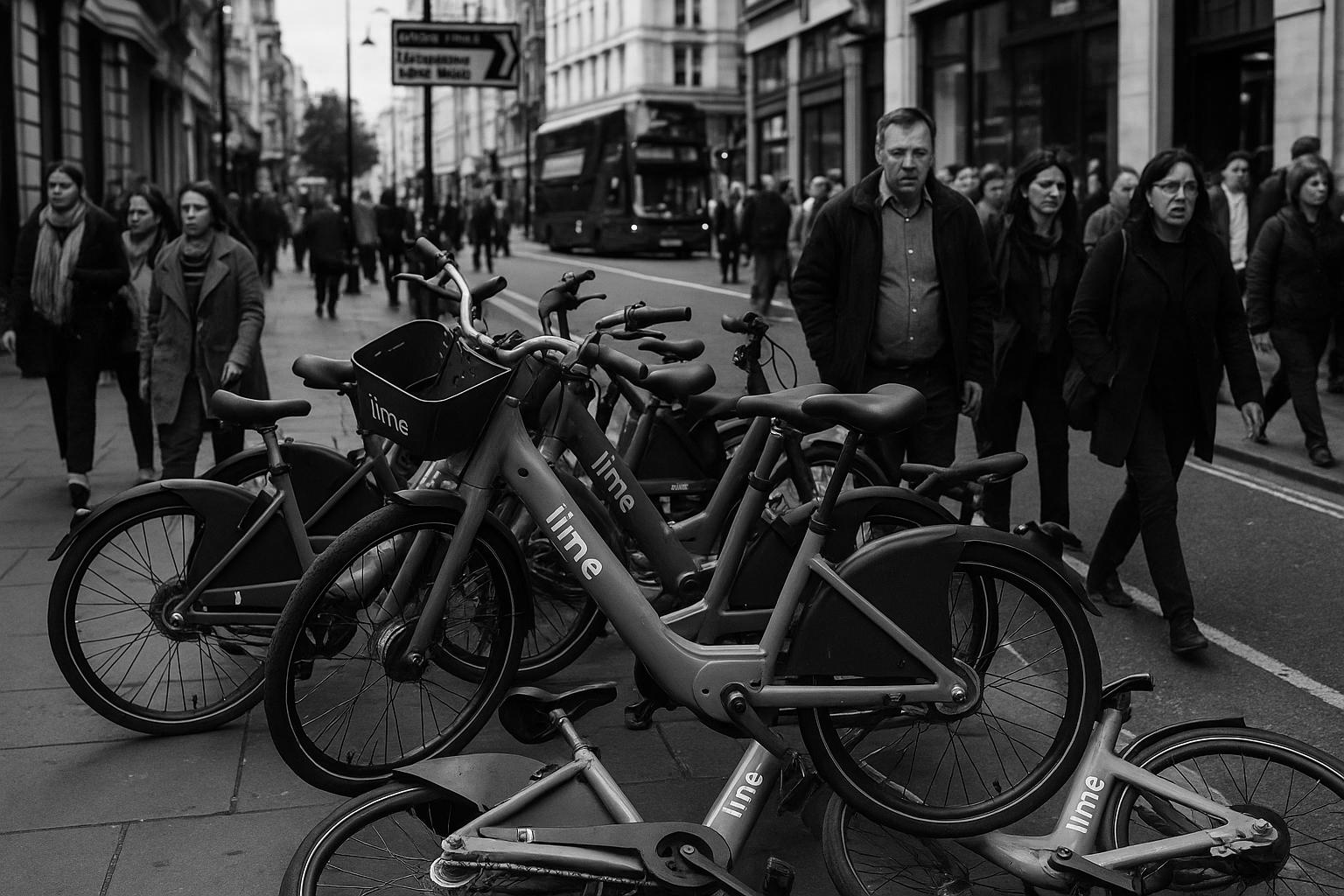Growing complaints over Lime e-bikes cluttering pavements and causing injuries have sparked demands for tougher regulation and cycling education in London. With hospitals reporting ‘Lime bike leg’ injuries and vulnerable pedestrians distressed by obstructed walkways, authorities and Lime pledge new measures amid ongoing tensions.
Lime e-bikes, those distinctive green hire bikes that have rapidly multiplied across London and other UK cities, are increasingly drawing frustration from pedestrians, local residents, and even celebrities. The 92-year-old actress Dame Joan Collins recently voiced her annoyance on Instagram about the “loutish” behaviour of Lime riders, sharing images of e-bikes abandoned en masse on crowded pavements. This disorderly parking is more than a nuisance; it poses significant hazards, especially for vulnerable groups such as blind and partially sighted individuals who struggle to navigate blocked walkways. The National Federation of the Blind UK has openly called for the removal of dockless e-bikes, highlighting the safety risks and loss of independence caused by these obstructions.
Beyond the clutter, the rise of Lime bikes has been linked to a spike in accident-related injuries. London hospitals have reported an uptick in admissions due to what orthopedic surgeons have termed ‘Lime bike leg’—serious injuries resulting from the heft of the bikes, which weigh over 30 kilograms, falling onto riders during crashes. Pedestrians are not spared from harm either; in a notable July 2024 incident, a 56-year-old woman walking her dogs in Crouch End, North London, was struck at speed by a Lime e-bike. The rider briefly stopped but fled, leaving the injured woman with a sprained ankle and bruising. Such episodes fuel ongoing concern about rider behaviour and the danger posed to those on foot.
The core of the problem, however, may lie in the riding culture itself. According to those familiar with cycling in places like Belgium—a country lauded for its extensive cycle networks and stringent regulations—British cyclists often lack the necessary awareness and adherence to road safety protocols. Unlike Belgium, where cyclists are expected to follow strict rules such as using bells, refraining from mobile phone use while cycling, and signalling clearly, enforcement in the UK is less rigorous, and many riders appear indifferent to the Highway Code. This has led to widespread issues like cyclists running red lights, riding on pavements, and neglecting basic signalling, creating unpredictable and hazardous conditions for all road users. The resulting tension between cyclists and pedestrians fuels calls for improved education and stricter enforcement, with some suggesting that irresponsible riders should lose access to Dockless hire bikes until they demonstrate proper competence.
Local authorities and organisations have been trying to grapple with these challenges. In Brent, North West London, residents have repeatedly complained about Lime bikes left in obstructive and sometimes hazardous positions, even leading to the removal of bikes found in rivers and canals. Similar grievances have emerged in Hounslow, where bikes have reportedly been abandoned deliberately in dangerous spots such as in the middle of roads or on pavements, blocking driveways and posing serious risks to pedestrians and motorists alike. These widespread concerns have prompted council calls for stronger penalties and deterrents, urging Lime to comply with local standards to safeguard pedestrian safety.
Responding to the outcry, Lime announced a £20 million investment plan aimed at alleviating the parking chaos. The company’s CEO, Wayne Ting, acknowledged the problems caused by rapid e-bike demand and pledged collaboration with local authorities to improve the cycling experience, including dedicated parking bays and enhanced operational measures. Transport for London (TfL) has also stepped up, adopting a stricter policy to tackle the issue of poorly parked e-bikes, particularly on TfL land, with intentions to penalise operators allowing such disruptions. Despite these initiatives, the situation remains contentious, with community members and advocacy groups pressing for swifter and more effective action to prevent further accidents and restore safe, accessible public spaces.
While Lime and governing bodies work towards solutions, the wider lack of a coherent cycling culture in the UK continues to jeopardise the safety of both riders and pedestrians. The contrasting experience of cycling in countries like Belgium offers a glimpse of what could be possible with consistent regulation, education, and infrastructure investment. Until then, the streets of London remain a battleground of competing road users, where obstructive bikes, frustrated residents, and accident reports highlight the urgent need for a safer, more respectful approach to urban cycling.
 Reference Map:
Reference Map:
- Paragraph 1 – [1], [3], [5]
- Paragraph 2 – [1], [2]
- Paragraph 3 – [1]
- Paragraph 4 – [5], [7]
- Paragraph 5 – [4], [6], [7]
- Paragraph 6 – [1]
Source: Noah Wire Services
- https://www.dailymail.co.uk/home/you/article-14841617/I-grew-Belgium-controversial-opinion-British-people-terrible-behaviour-trouble-home.html?ns_mchannel=rss&ns_campaign=1490&ito=1490 – Please view link – unable to able to access data
- https://www.standard.co.uk/news/london/lime-bike-crouch-end-north-london-crash-hit-and-run-b1186540.html – In July 2024, a 56-year-old woman was struck by a Lime e-bike while walking her dogs in Crouch End, North London. The rider collided with her at speed, causing her to fall and sustain injuries. The rider briefly stopped before fleeing the scene, leaving the woman bleeding on the road. She was left with a sprained ankle and extensive bruising. The incident highlights concerns over the safety of pedestrians due to e-bike usage in the area.
- https://www.mylondon.news/news/transport/lime-bikes-strewn-across-london-29841564 – Lime e-bikes have been causing significant issues in London, particularly for blind and partially sighted individuals. Abandoned bikes blocking pavements have made navigation challenging, leading to increased stress and reduced independence for those with visual impairments. The National Federation of the Blind UK has called for the removal of dockless e-bikes, citing safety concerns for pedestrians. The situation has prompted discussions about the need for dedicated parking bays and better management of e-bike schemes.
- https://road.cc/content/news/lime-clamps-down-obstructive-e-bike-parking-312383 – Lime has announced a £20 million plan to address the issue of obstructive e-bike parking in London. The initiative includes investing in dedicated e-bike parking, enhancing operational capacity, and implementing processes to improve service quality. Lime CEO Wayne Ting acknowledged the surge in demand for e-bikes and the associated parking challenges, emphasizing the company’s commitment to collaborating with local authorities to enhance the cycling experience for all Londoners.
- https://www.telegraph.co.uk/news/2024/09/19/how-lime-bikes-tore-apart-london-borough-brent-council/ – In Brent, North West London, residents have expressed frustration over Lime e-bikes being left in obstructive positions, blocking pavements and causing difficulties for pedestrians, including those with mobility aids. Local authorities have been forced to remove bikes from rivers and canals due to improper parking. The council has called for stronger deterrents and penalties for bad parking, urging Lime to comply with local standards to prevent obstructions and ensure pedestrian safety.
- https://www.bbc.co.uk/news/articles/c2dlw78dl2lo – Transport for London (TfL) has introduced a new policy to address the issue of poorly parked e-bikes causing access and safety problems. The policy aims to take action against operators who allow their bikes to be parked outside designated areas, particularly on TfL land. This move follows increasing concerns over obstructive e-bike parking and its impact on pedestrians and other road users in the capital.
- https://road.cc/content/news/locals-say-bikes-deliberately-left-dangerous-places-302767 – Residents in Hounslow, West London, have reported that Lime e-bikes are being deliberately left in dangerous locations, such as in the middle of roads or on pavements, blocking driveways and creating hazards. Locals have called for the trial of the bike hire scheme to be paused, expressing concerns that it is only a matter of time before someone is seriously injured due to the irresponsible parking of these bikes.
Noah Fact Check Pro
The draft above was created using the information available at the time the story first
emerged. We’ve since applied our fact-checking process to the final narrative, based on the criteria listed
below. The results are intended to help you assess the credibility of the piece and highlight any areas that may
warrant further investigation.
Freshness check
Score:
6
Notes:
 The narrative presents recent events, such as Dame Joan Collins’ Instagram post and the National Federation of the Blind UK’s call for the removal of dockless e-bikes, indicating a high freshness score. However, the article references incidents from July 2024, which is over a year old, and includes data from 2024, which may be outdated.
The narrative presents recent events, such as Dame Joan Collins’ Instagram post and the National Federation of the Blind UK’s call for the removal of dockless e-bikes, indicating a high freshness score. However, the article references incidents from July 2024, which is over a year old, and includes data from 2024, which may be outdated.
Quotes check
Score:
7
Notes:
 The article includes direct quotes from Dame Joan Collins and the National Federation of the Blind UK. While these quotes are attributed, no earlier instances of these exact quotes were found online, suggesting they may be original. However, the lack of online matches raises questions about their authenticity.
The article includes direct quotes from Dame Joan Collins and the National Federation of the Blind UK. While these quotes are attributed, no earlier instances of these exact quotes were found online, suggesting they may be original. However, the lack of online matches raises questions about their authenticity.
Source reliability
Score:
4
Notes:
The narrative originates from the Daily Mail, a publication known for sensationalism and potential biases. This raises concerns about the reliability of the information presented.
Plausability check
Score:
5
Notes:
The article discusses issues related to Lime e-bikes in London, including safety concerns and regulatory actions. While these issues have been reported by other reputable outlets, the Daily Mail’s sensationalist tone and potential biases cast doubt on the accuracy of the claims.
Overall assessment
Verdict (FAIL, OPEN, PASS): FAIL
Confidence (LOW, MEDIUM, HIGH): MEDIUM
Summary:
The narrative presents recent events and includes direct quotes, suggesting a high freshness score. However, the inclusion of outdated data, lack of earlier instances of the quotes, and the sensationalist tone of the Daily Mail raise significant concerns about the reliability and accuracy of the information presented. 













